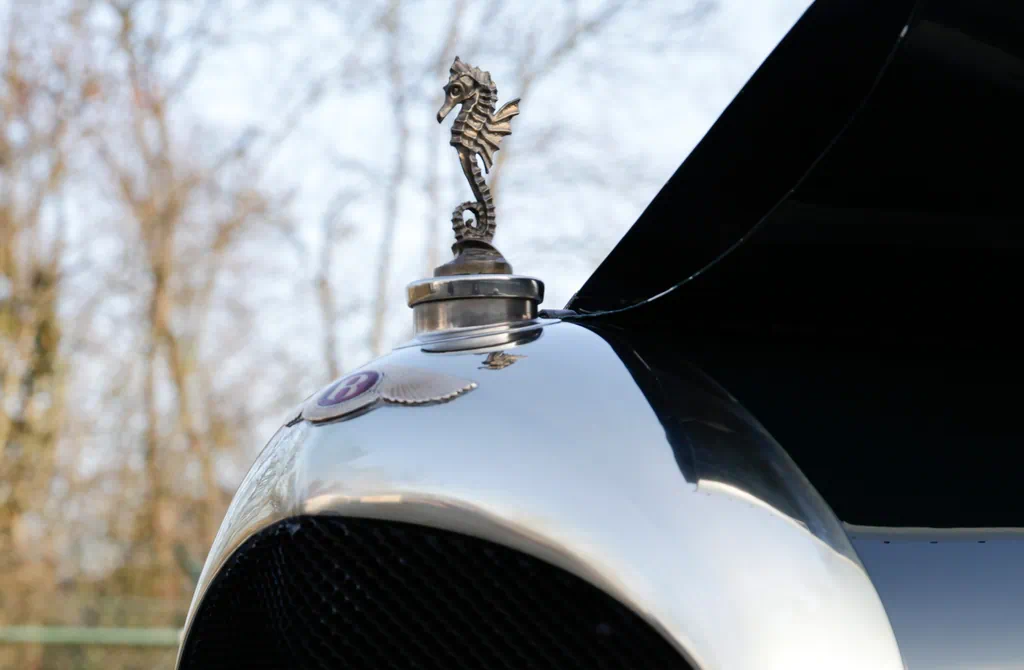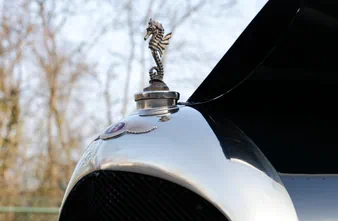The ZeitHaus multi-brand car museum is one of the world's leading automotive museums and part of the Autostadt in Wolfsburg. Its collection comprises around 260 vehicles by more than 60 manufacturers. When Anthony Methley ordered his Bentley 3-Litre Speed model in 1923, he could hardly have imagined that the car would one day be part of this collection, or that a bronze seahorse mascot would grace its bonnet in later life.
Methley placed his order for the motorised chassis and commissioned a coachbuilder of his choosing with the design of the bodywork – as was usual at the time. He was one of only 32 customers to order the 3-Litre and opted for the coachbuilder James Young & Co. – a Bromley-based bodywork specialist for exclusive customised designs established in 1863. Methley then collected his 3-Litre 4-seater tourer with James Young bodywork and the chassis number 506 from the Bentley works in Cricklewood on 24 February 1924. The entries in the Bentley service history book #506 are evidence of exemplary servicing over the next few years: the brakes were readjusted for the first time on 10 January 1925. In November – with 9,746 miles on the clock – the valve clearance was adjusted, and a steering wobble was sorted out. The first engine overhaul took place in 1927; the pistons, water pump and the crankshaft bearing were replaced later on. The meticulously handwritten entries in the #506 service history book also include accident repairs. The history ends in 1938 with a note stating that "various bushings and a propshaft bearing" had been ordered. The 3-Litre Bentley then disappeared from sight and did not resurface until 1940, when the boatbuilder Austin Packard Farrar visited a scrapyard near Lancing, Sussex, where he happened to find a 3-Litre Bentley – which was #506. Farrar purchased the car destined for the scrapheap for £20. He had the Bentley transported by train to his home in Portsmouth, where he breathed new life into the vehicle – and henceforth called it "Bumble" due to the sounds of its engine, which reminded him of the hum of a bumblebee. Farrar planned to use the vehicle as a "workhorse" to take the boats he had built to his customers by road. He replaced the Bentley "Flying B" mascot with a beautifully fashioned bronze seahorse – a symbol of the boatbuilder's close relationship with the sea. Austin Packard Farrar died in 2004 at the age of 91. The Autostadt in Wolfsburg acquired the #506 in 2006. "Bumble's" story – the story of the last surviving 3-Litre Bentley bodied by coachbuilder James Young and the seahorse mascot on the bonnet – will continue to be told at the ZeitHaus museum.
Background information Bentley 3-Litre
The 3-Litre prototype was first shown to the public at the 1919 London Motor Show – and went into production in Cricklewood with a 70bhp engine in 1921. The 3-Litre Speed was sold from 1924 onwards as a more sporty version – with almost 80bhp produced by a 2,996cc engine, four wheel brakes and a top speed of 90mph. The high-performance version "Super Sports" with almost 90bhp that was launched in 1925 was designed for motor racing – and won Le Mans in 1924 and 1927. A total of 1,619 "3-Litres" were manufactured between 1921 and 1929 – including 513 Speed models. The first Bentley Motors Ltd. model therefore also marked the beginning of a tradition of outstanding high-quality motorcars that lasts to this day.
Methley placed his order for the motorised chassis and commissioned a coachbuilder of his choosing with the design of the bodywork – as was usual at the time. He was one of only 32 customers to order the 3-Litre and opted for the coachbuilder James Young & Co. – a Bromley-based bodywork specialist for exclusive customised designs established in 1863. Methley then collected his 3-Litre 4-seater tourer with James Young bodywork and the chassis number 506 from the Bentley works in Cricklewood on 24 February 1924. The entries in the Bentley service history book #506 are evidence of exemplary servicing over the next few years: the brakes were readjusted for the first time on 10 January 1925. In November – with 9,746 miles on the clock – the valve clearance was adjusted, and a steering wobble was sorted out. The first engine overhaul took place in 1927; the pistons, water pump and the crankshaft bearing were replaced later on. The meticulously handwritten entries in the #506 service history book also include accident repairs. The history ends in 1938 with a note stating that "various bushings and a propshaft bearing" had been ordered. The 3-Litre Bentley then disappeared from sight and did not resurface until 1940, when the boatbuilder Austin Packard Farrar visited a scrapyard near Lancing, Sussex, where he happened to find a 3-Litre Bentley – which was #506. Farrar purchased the car destined for the scrapheap for £20. He had the Bentley transported by train to his home in Portsmouth, where he breathed new life into the vehicle – and henceforth called it "Bumble" due to the sounds of its engine, which reminded him of the hum of a bumblebee. Farrar planned to use the vehicle as a "workhorse" to take the boats he had built to his customers by road. He replaced the Bentley "Flying B" mascot with a beautifully fashioned bronze seahorse – a symbol of the boatbuilder's close relationship with the sea. Austin Packard Farrar died in 2004 at the age of 91. The Autostadt in Wolfsburg acquired the #506 in 2006. "Bumble's" story – the story of the last surviving 3-Litre Bentley bodied by coachbuilder James Young and the seahorse mascot on the bonnet – will continue to be told at the ZeitHaus museum.
Background information Bentley 3-Litre
The 3-Litre prototype was first shown to the public at the 1919 London Motor Show – and went into production in Cricklewood with a 70bhp engine in 1921. The 3-Litre Speed was sold from 1924 onwards as a more sporty version – with almost 80bhp produced by a 2,996cc engine, four wheel brakes and a top speed of 90mph. The high-performance version "Super Sports" with almost 90bhp that was launched in 1925 was designed for motor racing – and won Le Mans in 1924 and 1927. A total of 1,619 "3-Litres" were manufactured between 1921 and 1929 – including 513 Speed models. The first Bentley Motors Ltd. model therefore also marked the beginning of a tradition of outstanding high-quality motorcars that lasts to this day.





